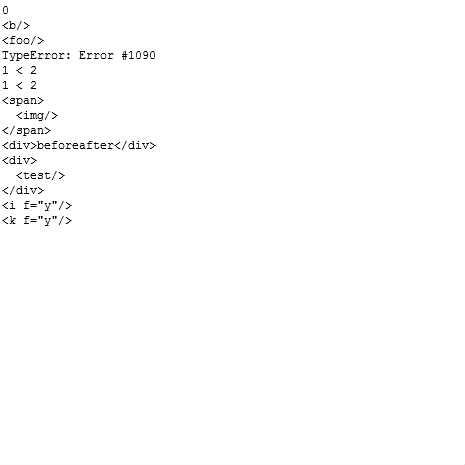notes on XML
♥2 |
Line 38 |
Modified 2011-07-03 09:47:14 |
MIT License
archived:2017-03-05 07:09:50
ActionScript3 source code
/**
* Copyright wh0 ( http://wonderfl.net/user/wh0 )
* MIT License ( http://www.opensource.org/licenses/mit-license.php )
* Downloaded from: http://wonderfl.net/c/lFFR
*/
package {
import com.actionscriptbible.Example;
public class FlashTest extends Example {
public function FlashTest() {
// these little empty tags make an XMLList, not an XML object.
var list:XMLList = <></>;
trace(list.length());
// you can populate XMLList like an array
list[0] = <a/>;
list[2] = <b/>;
// it automatically squishes out any sparseness
trace(list[1].toXMLString()); // <b/>
// constructing XML(String) parses it instead of making a text node
var foo:XML = new XML('<foo/>');
trace(foo.toXMLString());
// invalid syntax will cause an error
var str:String = '1 < 2';
try {
new XML(str);
} catch(e:Error) {
trace(e);
}
// then how do you create an text node from a string?
// escape it... AVM2 has "esc_xelem" op, but we don't have access to that
var text:XML = new XML(str.replace(/</g, '<'));
trace(text);
// something kludgy...
var text2:XML = <>{str}</>[0];
trace(text2);
// what happens when you use E4X?
var e4x:XML = <span><img /></span>;
// bytecode is more like:
// local = new XML('<span><img /></span>');
// i.e., it's parsed at run time.
trace(e4x.toXMLString());
var fancy:XML = <div>{'before' + <test/> + 'after'}</div>;
// bytecode is more like:
// local = new XML('<div>' + __esc_xelem('before ' + new XML('<test/>') + ' after') + '</div>');
// notice that this would implicitly call toString() on <test/>,
// which would return nothing, since it is "simple"
trace(fancy.toXMLString()); // nothing between before and after
var fancier:XML = <div>{<test/>}</div>;
trace(fancier.toXMLString()); // <div><test/></div>
// note that now the argument is of type XML, which survives
// what happens when you use filtering?
var haystack:XMLList =
<>
<i f="y"/>
<j f="n"/>
<k f="y"/>
</>;
var ik:XMLList = haystack.(@f == 'y');
// bytecode is more like:
// var _nodes:XMLList = haystack;
// var _i:int = 0;
// var _result:XMLList = new XMLList('');
// while (__hasnext2(_nodes, _i)) { // this sets _i to the next key
// var _node = _nodes[_i];
// with (_node) {
// if (@f == 'y') {
// _result[_i] = _node;
// }
// }
// }
// ik = _result;
trace(ik);
}
}
}

